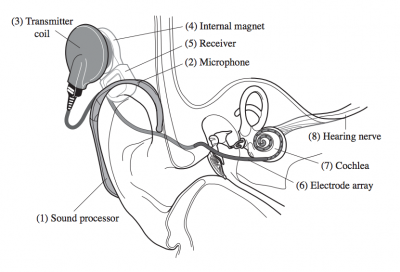What is a cochlear implant?
We are not going to go into great depth here. There are many detailed descriptions and a wealth of information available on the internet, so we are just giving you a brief, non-technical outline.
A cochlear implant is a surgically implanted device suitable for severely/profoundly deaf children and adults who do not derive sufficient benefit from hearing aids. For these individuals cochlear implants are by far the best that technology can do to reduce the adverse impact of deafness at the present time.
The device consists of two parts:
- The external part: a battery powered sound processor (1) with a microphone (2) and, on the side of the head behind the ear, a transmitter coil (3) which is attached magnetically (4) to……
- the internal part (not visible externally): a receiver (5) surgically implanted in the mastoid bone behind the ear; attached to it is an electrode array (6) that is inserted into the cochlea (7). (There are various types of electrode arrays to suit different cochleas.)

Following referral to a cochlear implant centre, a thorough assessment will take place to determine a child’s suitability for the procedure. In the past children were only offered one cochlear implant. However, nowadays unless one ear has good residual hearing or there is a medical reason to only implant one ear, children are routinely offered bilateral cochlear implantation. It is also possible for children who already had one implant at 28 January, 2009, to have a sequential bilateral implant if the responsible clinician considers it would provide sufficient benefit. See bilateral cochlear implantation.
Surgery may require an overnight stay in hospital although in many cases the procedure is now performed as a day case. Around four weeks later the device will be ‘switched on’ and the child’s journey into the world of sound begins. There will then be ongoing routine visits to the implant centre to programme the device and monitor the child’s progress. Models of rehabilitation vary from centre to centre. For example, for the first year some may ask the child to visit the centre for regular therapy, some may offer Auditory Verbal Therapy for a fixed period, others may have a teacher of the deaf and/or speech and language therapist who visit the child at home and school over a longer period and work with the family and local team to deliver support.
Note: There are other implantable devices for different types of deafness which are not covered on our site: (a) bone anchored hearing devices (for conductive hearing loss, mixed hearing loss or single-sided deafness) use bone conduction to transfer sound to the inner ear; (b) middle ear implants (for mild to severe sensorineural, conductive or mixed hearing loss) if conventional hearing aids cannot be worn, eg because of chronic ear infections; (c) electro-acoustic implants (for mild to moderate hearing loss in the low frequencies and severe to profound loss in the high frequencies) combine cochlear implant and hearing aid technology in one device. The hearing aid component amplifies the low pitches and the cochlear implant provides stimulation for higher pitches; (d) auditory brainstem implants can be used in exceptional cases of profound hearing loss when a cochlear implant cannot be used, for instance if there is no cochlea or auditory (hearing) nerve. We suggest using the internet for further information about these devices.